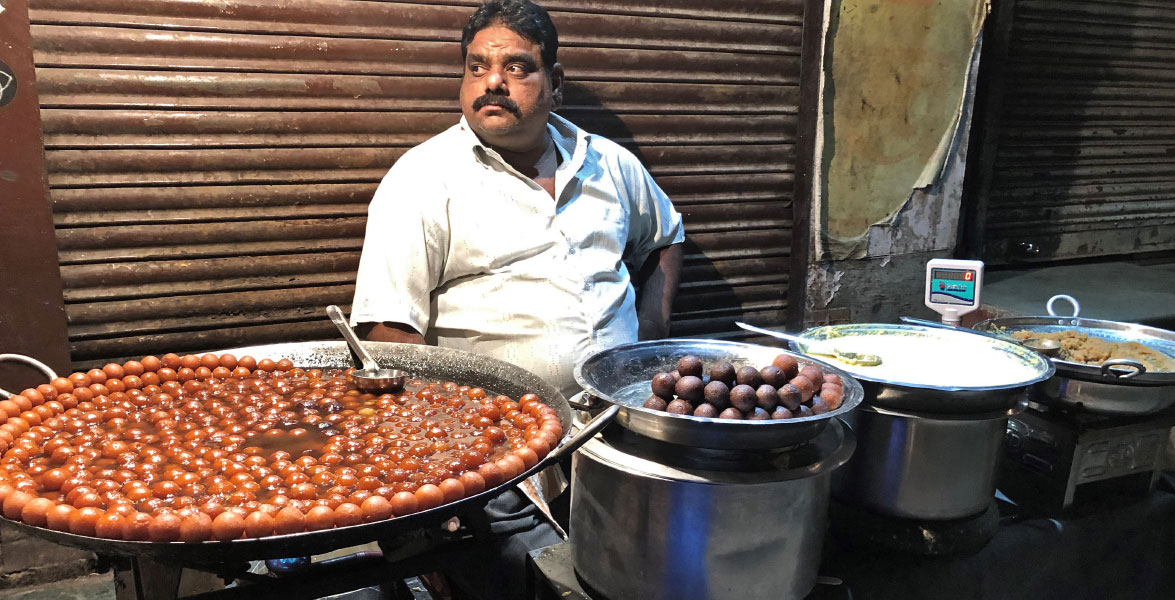When you have to cover the proceedings of a Rotary Zone Institute for the magazine, in however spectacular city the conference may be held, you can say goodbye to really seeing or “experiencing” the city, in all senses of the word. Unless you are a late-night swinger, which I am not!

So when the Zone Institute of RI Director Bharat Pandya was announced at Indore, the first thing one thought about was the mouth-watering street food that Indore has on offer. Its Sarafa Bazaar is legend when it comes to street food. The first, and only, free evening had to be grabbed. Landing at the Indore airport in the evening, with my colleague Muthu, who can hardly be described a foodie, given that he can live happy for an entire year on thayir sadam (curd rice), with a modest vegetable thrown on the side, after a quick check in, I marshalled my colleague Jaishree and PDG Shyamashree Sen — both confirmed street food lovers — and headed for Sarafa Bazaar. Muthu tagged along… more as a photographer, and an observer of our hogging, than a consumer!

Indore’s street food, we had been warned, comes alive only after 9 pm and we hit the Sarafa Bazaar, a jewellery market by day, just after 9 pm, to explore what it had on offer. The first thing that hits you on this street are huge, inviting round platters loaded with the most tempting sweet delicacies, ranging from gulab jamun to rabri/firni to jalebi (incidentally it was in Indore, I learnt the difference between the jalebi and imarti, of all the places, at the breakfast table, and out of all the people, from PDG Raju Subramanian!). Then there are the halwas of course… from gajar halwa to moong ka halwa, as well as the piping hot malpuas! Trust me, one stomach is not enough to enjoy Sarafa!

We first went in for the most recommended item in Sarafa — garadu which is made from yam, is fried and spiced up with a chatpata masala powder. It was okay; it didn’t really tantalise my tastebuds. What did were the aalu spirals, thinly sliced potato done up in a spiral, topped up with cheese and chaat powder and fried to a delicious, soft golden brown. It was a perfect mix of crunchy and soft, and spicy.

Helpfully, at the very next stall was an offering of “coconut crush”, which a little disappointingly, was only tender coconut served with coconut water, making one yearn for the yelaneer payasam (tender coconut payasam), a South Indian delicacy. With this not being sinful enough, our next stop was at the jalebiwala who offered to fry for us a fresh batch. The offer was taken and the delicious fare lapped up hot on a lovely, cool early winter evening.

As Muthu politely turned down almost everything, only gratefully lapping up the more familiar tender coconut water, and was happy clicking away, the three of us continued our pursuit of more delicacies, stopping to try some “corn kiss”, which was passable, till we laid our eyes on the pani puri guy. The different types of water on offer were not as varied as the ones you find in Ahmedabad, but the pani puri was delicious and we gorged on it, till we couldn’t have any more. And after all this eating, we had spent hardly ₹500, not counting the ₹250 or so spent for the “coconut crush”.

Totally stuffed, we could only leave envious glances at the vendors offering all kinds of paav bhaji, momos, chaats and a host of other delicacies, till we came to the Delhi Kulfi stall. By now it was midnight, and we unanimously concluded — all four of us — what’s a winter night without a delectable kulfi? It was two mango and two sitafal kulfis, and it melted in the mouth. Fulfilled, happy and almost singing, we marched on, meeting DG Kiranlal Shrestha from Nepal, enjoying jhaal muri. Soon the stalls selling a wide variety of paans caught our eye. The famous “smoke paan”… the type that lights a fire in your mouth and only the very brave go for it… was of course there, but it was accompanied by equally exotic stuff such as cherry paan, strawberry paan, chocolate, mango, butterscotch, leetchi paan… you name the fruit and it was there.

No, we didn’t try the paans; after all there should be a reason to return to Indore’s Sarafa.
If you notice, almost all the shops had the facility to pay through scanning the Paytm QR code, which makes payment so easy. Some of the vendors such as Susheela who served us the corn kiss, has been here for 15 years. Most of them pay between ₹8,000 to ₹10,000 to the shop owners for the space. But business is good, and when you ask for their daily earnings, you get big smiles and no numbers!

While the food was awesome, what was even more awesome was that a street like Sarafa, which must be getting thousands of footfalls every evening, manages to remain reasonably clean. When you have finger food, your fingers need to be wiped, or washed. But most of the shops do not offer paper napkins… Mahesh, the young jalebiwala had this explanation: “Ma’am, giving paper napkins is not a problem; the problem is that most of the people who come here are tourists, and they simply wipe their hands and throw the napkins on the road, but we will be fined by the municipality.”
It’s with good reason that Indore has been smashing the charts as India’s cleanest city for a few years now!
We were told that at 2 am when the market winds up, the Municipal Corporation cleaners are there within 15 minutes and next morning the shopkeepers come to a spanking clean bazaar.
Pictures by Rasheeda Bhagat and V Muthukumaran







